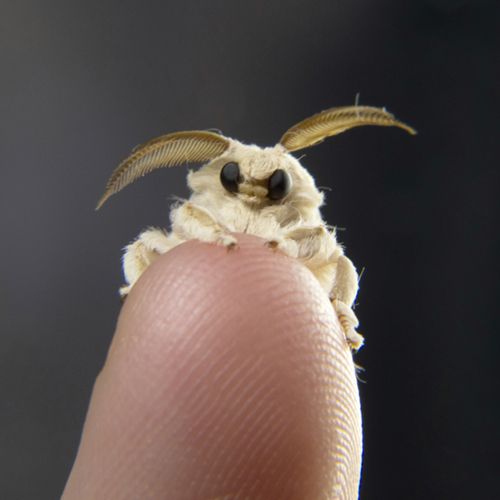My Cart
Your Shopping Cart is currently empty. Use Quick Order or Search to quickly add items to your order!
 Polly Dornette
Polly Dornette
Product Developer
A Chinese proverb states, “With time and patience the mulberry leaf becomes a silk gown.” A true statement; however, a little help from the silkworm Bombyx mori is also required.
Silkworm eggs are lemon yellow when laid, but turn white or black within a few days. White eggs are infertile and black eggs are fertile. Once laid, eggs typically hatch in about 2 weeks, but the incubation period is temperature dependent. Freshly hatched caterpillars (larvae), also called silkworms, look like small black strings.
Once hatched, silkworm larvae normally eat only mulberry leaves; however, they will consume an artificial diet when raised in captivity. As they grow and mature, caterpillars become grayish white in color. The caterpillars molt 4 times passing through 5 larval instars (an instar is the stage between molts) over a period of 23 to 28 days. During this time, the larvae grow to be about 3 inches in length, 10,000 times their size at hatching. The caterpillar has 6 legs, just as it will when it becomes a moth (adult). Each of a larva’s body segments has a dot, or a spiracle, on its side that is used for breathing.
After the 4th molt, the caterpillar begins to secrete a single, continuous silk fiber through its salivary gland. The strand of silk produced by a silkworm is usually about 1 mile long. The caterpillar moves its head in a constant figure eight pattern to wind the silk fiber around its body to form a dense cocoon. It takes about 3 days for a caterpillar to spin its cocoon. The caterpillar should not be disturbed during this time as a disruption will cause it to restart its cocoon—or could even kill it. If you hold a newly formed cocoon up to a light, you may be able to see the larva moving its head around inside. In its 2″ long cocoon, the larva undergoes metamorphosis to a chrysalis.
Approximately 3 weeks later, the organism cuts through the cocoon and emerges as a moth. After emerging, moths release a reddish brown fluid known as meconium, a waste product that could not be released while they were in their cocoons. Moths do not eat or drink and survive only long enough to reproduce. Males and females mate with their posterior ends stuck together. Females will lay about 500 eggs in less than a week.
For commercial silk production, cocoons must be intact. Newly formed cocoons are placed into hot water to kill the chrysalises and dissolve the sticky substance that holds the silk threads together. The silk fiber from the cocoons is wound onto spools. Silk thread can be dyed, but it is naturally white or gold in color.
Despite their small size, silkworms have played a significant role in shaping cultures throughout Europe and Asia. Sericulture, silkworm cultivation for silk production, has been practiced for over 5,000 years in China and in Europe as early as the 6th century AD. According to Chinese legend, silk was discovered by an ancient Chinese princess when a silk cocoon fell into her tea. When she tried to remove the cocoon, the silk fibers unraveled in her hand.
The Chinese spun up to 48 silk fibers to create silk threads that were then woven into luxurious silk cloth. Silk’s commercial value was quickly realized and the secret was closely guarded for nearly 3 millennia. Smuggling silkworms, silkworm eggs, or even white mulberry seeds from China was punishable by death.
The Silk Road, an extensive collection of up to 6,000 miles of trade routes between China and the Mediterranean Sea, was established and lead to the development of civilizations along its routes. In addition to the fabric that was transported via the Silk Road, religion, culture, technology, and even disease were exchanged among civilizations that included Persia, Greece, Syria, Rome, Armenia, and India.
Constantinople, the Byzantine capitol now known as Istanbul, began weaving raw silk purchased from China around the 4th century. In the mid-6th century, 2 Byzantine monks were able to smuggle silkworm eggs and mulberry seeds to Constantinople in hollowed out canes, thus allowing the Byzantines to establish European silk production. Byzantine silk dominated silk production in Europe until the 12th century when the industry began booming in Italy. The flourishing Italian silk industry may have been partially responsible for funding the Renaissance.
In the mid-20th century, German chemist Adolf Butenandt sought to isolate pheromones from silkworms. He eventually was able to isolate bombykol, a chemical released by the female silkworm moth to attract mates. The isolation, analysis, and ultimately the synthesis of this pheromone has proven beneficial for controlling insect populations.
Considerable research has been done into the science of silk. Silk is a protein consisting primarily of glycine, alanine, and serine. The smoothness of silk is due to these 3 amino acids having the smallest size groups of all amino acids (-H, -CH3, and –CH2OH, respectively). This amino acid chain forms a pleated-sheet structure that is resistant to stretching, a well-known property of silk.
Attempts to produce a man-made version of silk have resulted in the development of new materials. Rayon, previously referred to as viscose silk, is one attempt at a synthetic form of silk developed in the early 20th century. Rayon has similar dying properties to natural silk and a high luster, but it lacks the strength of natural fibers. In 1938 a chemist working for DuPont developed nylon, which exhibits many of the same properties as silk at a much lower cost. In addition to being woven to make fabric, nylon has been used for toothbrushes, fishing line, and rope.